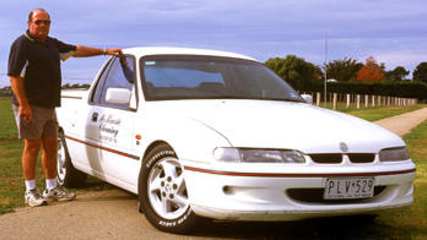Used Holden VS Ute review: 1995-2000
By Graham Smith · 03 Jun 2003
THE Holden ute was a favourite work wagon for farmers, tradesmen and small business owners from the day of its introduction in 1951, and it was a sad day when it disappeared from showrooms with the demise of the WB in 1984.Holden launched a new Commodore-based VG ute in 1990, but it was not the worker of old. Where the traditional Holden ute was a real workhorse with a tough full chassis and useable payload, the Commodore ute was a bit of a lightweight softie by comparison.It was based on the long-wheelbase Commodore, so there was no chassis, and it had coil springs in the rear instead of leafs. The payload of 710kg was well down on the payload of the old utes, particularly the one-tonne chassis-cab.The Commodore-based ute had plenty to live up to, given that the series of utes that kicked off with the HQ in 1971 and ran through to the WB in 1984 were tough old trucks that stood up to the abuse of daily life on the work site for years.Tradesmen and farmers were quickly attracted to them for their combination of performance, comfort and ability to carry a real workload, while in recent years they have become a favourite of a new generation looking for a cool vehicle for weekend getaways.Those who held the old Holden utes in such high regard thumbed their nose at the Commodore-based ute when it first arrived and it wasn't immediately accepted as a real workhorse. It was the ute driven to the work site by the boss, not the workers.It was more likely to carry the lunches rather than the tools of trade. The VS ute introduced in 1995 was the final evolution of the original Commodore-based ute before the all-new VU model came in 2000.It remained something of a softie in work terms, but had gained greater popularity as a sports ute which was a cool daily driver that could carry the sports gear at the weekend.THE VS was a facelift, but it was a much refined version of the VR ute which first saw the light of day in 1993. Like its passenger car cousins, the VS utes were little different on the outside from their predecessors. Most of the changes took place under the skin.The big news was the ECOTEC V6 engine which, while seemingly identical to the 3.8-litre V6 it replaced, was almost entirely new: smaller, lighter, smoother and more fuel-efficient than its predecessor. Capacity remained at 3.8-litres, but it had a new block, heads, manifolds and an all-alloy cast sump.The electronics were upgraded with a new computer, as well as a hot-wire air-mass sensor and sequential fuel-injection. It all added up to 17kW more power, which was now 147kW at 5200 revs with peak torque of 304Nm at 3600 revs. But there was also a 6 per cent improvement in fuel consumption, while meeting exhaust emission rules. Transmission choices were a five-speed manual box and four-speed electronic auto.A Series II upgrade in 1996 can be identified by Series II badges and oval-shaped side blinker repeater lights. It also brought a number of small improvements, including a new five-speed German Getrag manual gearbox for the V6. Mid-1998 saw a Series III upgrade, identified by Series III badges and clear side blinker repeater lights.There were also a number of interior upgrades, and for the first time there was a 5.0-litre Holden V8 SS model to complement the previous range which was limited to the standard Commodore and S models. The SS was distinguished by a neatly integrated body kit made up of front bumper and side skirts. There was also a polished alloy rear sports bar, 16-inch alloy wheels, fog lamps and SS decals.The SS V8 gave the hottie ute plenty of tail-wagging performance with 168kW driving the rear wheels through a five-speed manual and a limited-slip diff. ABS and sports suspension helped keep it in line, which was nice when the rear inevitably stepped out under enthusiastic acceleration.Inside there was leather wrapping on the sports steering wheel, hand brake and gearshift knob. The seats had SS identification, there were power windows and airconditioning was standard.The arrival of the SS was a clear indication that the Holden ute had become as much a lifestyle vehicle as it was a hard worker.EARLY VS utes will now have upwards of 200,000km showing on the odometer, which should be enough to have potential owners approaching them with caution. 1995 VS utes start at $9000, with a premium of $800 for the auto, while the S model starts at $10,500 in manual form and $11,200 with the auto.2000 Series III models run as high as $15,700 for the base six-cylinder manual ute -- add another $1000 for the auto. S models will cost as much as $18,000 in manual form with a similar premium for the auto trans, and the SS will run to $22,500.THE Holden ute's body and chassis are robust and reliable, and little trouble is reported from the field. Likewise the V6 engines are generally robust with a number of owners reporting untroubled motoring well above 200,000km.Look for oil leaks from the rear main crankshaft seal and around the oil pan, and also from the power steering pump. Fuel pumps tend to fail around the 200,000km mark. One owner was less than happy when his engine had to be replaced because of a worn camshaft at quite low mileage, and he says the telltale noise is back again. Overheating in autos in VS II utes can lead to transmission problems at around 100,000km. It can't be fixed simply by changing the oil, and Holden rebuilt or replaced a number of transmissions. Holden fixed the problem by releasing an oil cooler kit which can be retro-fitted.Noisy diffs are also a widespread problem. It's important to use the Holden-recommended oil in diffs to avoid a howling rear-end. Diff seals can also be a problem.








